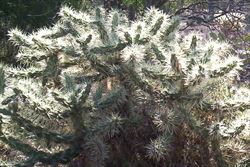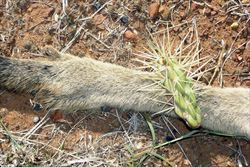Click on images to enlarge

infestation (Photo: Lucy Kirjan)

habit (Photo: Lucy Kirjan)

stem segment on native animal (Photo: Lucy Kirjan)

stem segments attached to vehicle (Photo: Lucy Kirjan)
Scientific Name
Cylindropuntia rosea (DC.) Backeb. and and Cylindropuntia tunicata (Lehm.) F.M.Knuth
Synonyms
Cylindropuntia rosea (DC.) Backeb.: Cylindropuntia pallida (Rose) F.M. Knuth; Opuntia pallida Rose;Opuntia rosea DC.
Cylindropuntia tunicata (Lehm.) F.M.Knuth: Opuntia tunicata (Lehm.) Link & Otto var. tunicata; Cactus tunicatus Lehm.
Family
Cactaceae
Common Names
Hudson pear
Origin
Native to Mexico.
Naturalised Distribution
Naturalised in some inland regions of Australia, though not currently very widespread. It is locally common in some parts of northern New South Wales (i.e. around the opal mining areas of Lightning Ridge, Grawin and Glengarry and at Cumborah) and infestations have also been reported from Brewarrina, near Coonamble and near Goodooga. It is also present in the inland regions of southern Western Australia and possibly naturalised in South Australia.
Cylindropuntia tunicata is naturalised at 3 locations in Queensland.
Cylindropuntia rosea is also naturalised overseas in South Africa.
Habit
Densely branched cactus to 1.5m high and 3m wide
Distinguishing Features
Hudson pear (Cylindropuntia rosea and C. tunicata)
- cylindrical stem segments that break off easily
- spines to 6 cm long white (C. rosea) or straw coloured (C. tunicata)
- pink-purple flowers (C. rosea) or yellow green flowers (C. tunicata)
- fruit 2-5cm long, single (not in chains)
Stems and Leaves
Stem segments easily detach, whorled or subwhorled, to 90 cm long (C. rosea) or to 25 cm long (C. tunicata ), with 4-20 spines per aerole. Spines are 3-6mm long, white in C. rosea and straw-coloured in C. tunicata.
Flowers and Fruit
Flowers pink or purple (C. rosea) or yellow to yellow-green (C. tunicata). Fruit are 25-50mm long, 8-15 mm wide, pulpy, tuberculate and with few spines.
Reproduction and Dispersal
The fruit are considered to be sterile. The plant is spread by segments.
Environmental Impact
Capable of causing serious injury to animals and humans.
Other Impacts
Spines can penetrate tyres and footwear
Legislation
Queensland: Class 1 - introduction into
the state is prohibited, and landowners must take reasonable steps to keep land
free of this species (throughout the entire state). It is also illegal to sell a
declared plant or its seed in this state. This declaration applies to all species
of Cylindropuntia except C. spinosior, C. fulgida and
C. imbricata (all Class 2)
Similar Species
Expert identification is recommended. Both are declared Class 1 in Queensland.
Notes
Hudson pear (Cylindropuntia rosea or C. tunicata) is considered to be an environmental weed in New South Wales, and was recently listed as a priority environmental weed in one Natural Resource Management region. It is already a serious weed in parts of northern New South Wales, where estimates of the area infested range from 60 000 to 100 000 hectares.
This species does not produce seeds (i.e. it is sterile) and only spreads vegetatively by pieces of its stem segments, which root where they come into contact with the ground. Dense infestations can displace native flora and may impact on plant biodiversity in semi-arid communities. It also poses a threat to native fauna and the spiny nature of the plant has been reported to cause the deaths of native animals (e.g. koalas).
Cylindropuntia rosea is thought to be a hybrid between C. tunicata and another unkown parent.

